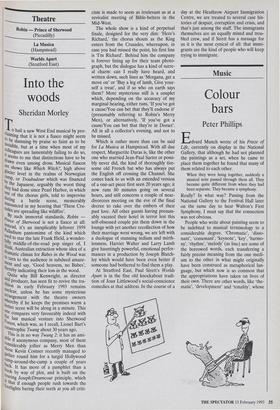Music
Colour bars
Peter Phillips
Edvard Munch wrote of his Frieze of Life, currently on display in the National Gallery, that although he had not planned the paintings as a set, when he came to place them together he found that many of them related to each other.
When they were hung together, suddenly a musical note passed through them all. They became quite different from when they had been They became a symphony.
Really? In what way? Passing from the ry National Gallery to the Festival Hall later on the same day to hear Walton's First Symphony, I must say that the connection was not obvious. People who write about painting seem to to a ant', 'ke be indebted to musical terminology considerable degree. 'Chromatic', 'disso- nant', `consonant', 'key', 'harmo- ny', 'rhythm', 'melody' (as line) are some of the borrowed words, each transferring a fairly precise meaning from the one medi- um to the other in what might originally metaphorical common that the been construed as etaphorical lan- guage, but which now is so comhat the appropriations have taken on lives of their own. There are other words, like 'the- matic', 'development' and 'tonality', whose origins are sufficiently general for neither art form to be able to claim primacy. There are yet others, like 'counterpoint', 'fugal' and 'modality', which refer so precisely to a musical technique that applying them to a painter's work is indeed to use colourful language (and presuppose some specialist knowledge on the part of the reader). By and large, though, the concepts behind the words are clear, even to someone who knows little of music, and should lead to greater understanding of the painting. But Munch went a lot further: 'a musical note' is exact, a 'symphony' apparently no less so.
In one way the Frieze of Life makes rather good material for comparison with a musical symphony. Although it seems to be made up of too many paintings to approxi- mate to the number of movements in a symphony, this quantity is misleading. Munch worked with a succession of motifs — the Kiss, the Scream, the link between woman and death as in the Vampire, Melancholy, Sickness, what Berlioz had called idies fixes — which he explored by a methodical examination of their themes. One could argue that in many of these cases, from his initial drawings through var- ious intermediate stages to the final paint- ings, there is something resembling exposition, development and recapitula- tion, to borrow the vocabulary of sonata form, and if there are no musical sym- phonies which are made up of some 15 movements, all in this one form, then per- haps I am at last being too literal.
Munch probably wasn't too bothered about sonata form; but the connection between music and colour may have come to him almost instinctively. At the time he began the Frieze, in the early 1890s, there had been a general moving together of music and painting over the issue of colour. James McNeill Whistler had for some time been exploring the possibilities inherent in `symphonies of colour', a term which found its complement in Scriabin's fascination for giving all the major and minor keys a colour code and then composing, as it were, paintings. He even had plans to design a 'colour organ' to play these works. The ambiguity of the word 'tone' had for years been at the heart of the so-called `tone-poem', invented by Franz Liszt, in which, whatever its connection with poetry, purely musical structure was subordinated to the recounting of a story in a pictorial and colourful way. The tone-poem is also known as the 'symphonic' poem, which rather conveniently brings me back to Munch's claim.
I hope this shows that Munch's reference to a symphony, for all that the original Greek word implies sound, is not wholly off the beam, but has respectable antecedents. His 'musical note' is more difficult. As I see it, its explanation must lie in the tenets of Expressionism. Strange to say, this artistic movement, over which Munch had so much influence, spawned a musical equivalent (and it was that way round), with which Schoenberg, Berg and Webern at various times were associated. In the vocal writing of Schoenberg, at least, screaming is regu- larly called for. Now if any single image may be said to run through Munch's Frieze it must be that of the Scream. Given his habitually tempestuous state of mind I can just about believe that Munch could have heard a scream as a musical sound, even if only subconsciously. No?



















































 Previous page
Previous page